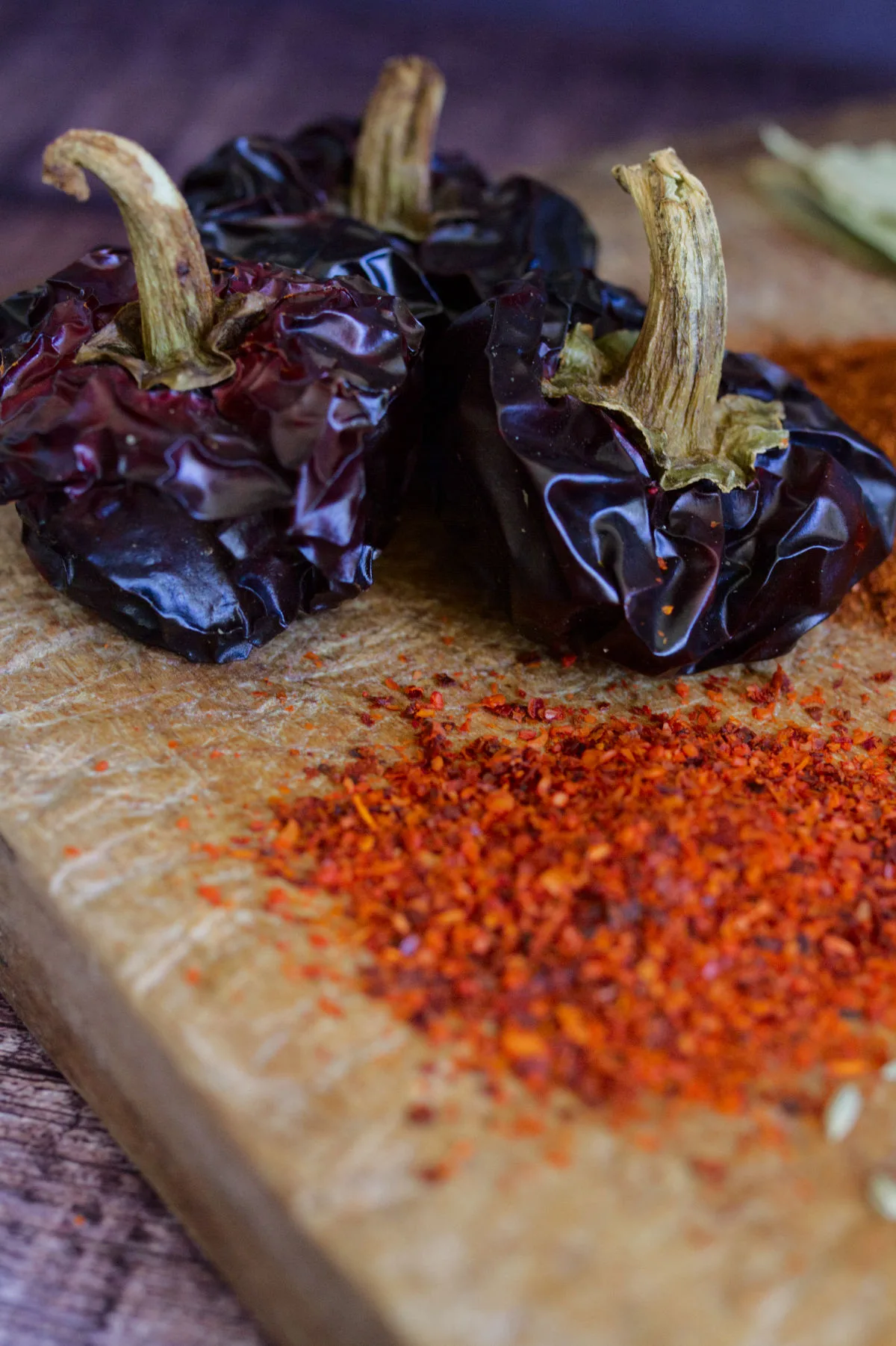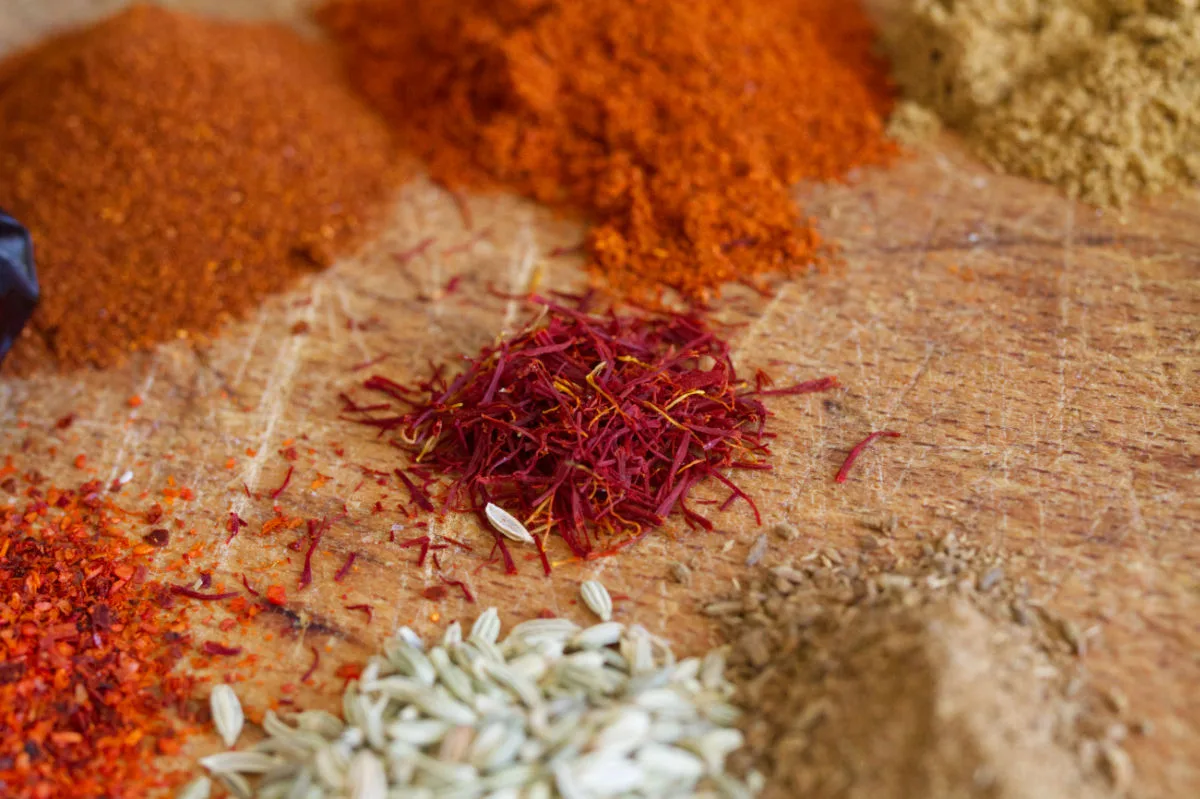The 7 Most Used Spices in Spanish Cooking
(Uses, Health Benefits, Recipes)

We’ve found that Spanish cuisine is as diverse as its regions, and its richness lies not only in the abundant choice of fresh ingredients but also in the artful use of spices. Nearly every non-dessert recipe uses at least one spice (and many desserts feature one, usually cinnamon).
Let’s delve into the core of Spanish cooking to unveil the top seven spices used in Spanish cuisine. We will also discover the dishes they commonly accentuate plus take a look at some of the health benefits that each of these commonly used spices can provide.
As a quick side note, one of the reasons Spanish cuisine is healthier than some others is thanks to the use of spices. This often leads to less, or even no salt being used in a recipe. So if you’re trying to reduce your sodium intake, try to up your spice game.
1. Paprika (Pimentón)
The Sweet, Smoky, Fiery Heart of Spanish Cuisine
Paprika, or Pimentón in Spanish, is the cornerstone of Spanish cuisine. It’s so common and popular because of its versatility and the fact there are three varieties of Spanish paprikas:
- Peppery-sweet flavor of Pimentón Dulce
- Smoky taste of Pimentón Ahumado
- Fiery kick of Pimentón Picante
Try it in the iconic Patatas Bravas tapas dish, or a more modern spin on tapas with paprika-infused pork bites, or in the famous Spanish sausage, Chorizo.
As an added bonus to it bringing loads of flavor to the table, paprika offers substantial health benefits. It’s rich in antioxidants and has anti-inflammatory properties, making it a heart-healthy addition to your diet and offering the potential to prevent the onset of chronic diseases like cancer.
2. Saffron (Azafrán)
The Red Gold of Spain
Saffron, or Azafrán, is one of the world’s most expensive spices (if not the most) and a jewel in Spanish cuisine. Just a few threads of this crimson spice can transform a dish, so while it’s expensive as an initial outlay, a little really does go a long way. It’s a key ingredient in many rice dishes like paella (the iconic rice dish from the Valencia region), infusing it with its distinctive golden hue and subtle floral notes.
Apart from its dazzling color and flavor, Saffron’s health benefits include helping with depression, Alzheimer’s disease, and weight loss. Another staple in Spanish cooking that can help with weight loss is olive oil.
3. Cumin (Comino)
The Earthy Spice with a Powerful Aroma
Cumin, or Comino, brings an earthy and slightly nutty flavor to Spanish dishes. Its warm, spicy aroma is irresistible — it’s also powerful, so go easy with this spice so it doesn’t overpower a dish. It plays an important role in many recipes from no-mayo Spanish potato salad to Maravilla stew with chickpeas.
In addition to its taste, cumin may aid digestion and improve blood sugar control. It also contains flavonoids which help fight free radicals in the body, a key factor in preventing chronic diseases like cancer and high blood pressure.
4. Cayenne Pepper (Pimienta de Cayena)
The Spice to Give Spanish Dishes Heat
Cayenne pepper, or Pimienta de Cayena, is the other spice apart from spicy paprika to give a dish some heat. Spanish meals are by no way spicy in comparison to countries that like it hot, so the go-to is usually cayenne pepper powder (or Ñora — see below) over super hot chili flakes or dried chilis.
It is used across a broad range of Spanish recipes, including spicy chicken and chorizo rice and spicy Mediterranean chicken thighs.
From a health perspective, cayenne peppers contain capsaicin which can help relieve pain and lower blood sugar levels. They’re also a fiery source of many nutrients including vitamin C, A, and B6.
5. Bay Leaves (Hoja de Laurel)
Aromatic Elegance in Spanish Stews and Casseroles
We’re including bay leaves, or Hoja de Laurel, as they straddle the spices-herbs divide. Often considered a herb, they are typically used like a spice. Just a few bay leaves can infuse a pot of Spanish white bean stew (vegan), or oven-baked fish casserole with romesco sauce, with a delightful, earthy flavor.
Even though we don’t consume them directly, bay leaves are still valued for their health benefits, including anti-inflammatory and antimicrobial properties.

6. Ñora Peppers and Flakes
The Heart of Iconic Rice and Noodle Dishes
Ñora chili peppers are small red peppers found in the Valencia region and Murcia region. They can be used to become paprika or a Ñora flakes spice combo that is commonly used in paella and other rice or noodle dishes like seafood fideuà or oven-baked rice with cauliflower and green beans.
Ñora peppers have many nutrients including vitamins E and A, plus folic acid, carotene, and potassium. They also contain antioxidants, can reinforce the immune system, and stimulate hair growth.
7. Fennel Seeds (Semillas de Hinojo)
Anise-Infused Delight
Fennel seeds, or Hinojo, give a mild anise flavor to dishes, while adding a subtle sweetness and aroma. They are versatile and can be as easy as adding ground fennel seeds to salads to give them a refreshing boost: try spicy grilled shrimp with tangy peach salad and a 5-minute Spanish tomato salad to taste the difference.
Apart from flavor enhancement, fennel seeds can help your health in many ways including aiding digestion, improving eyesight, promoting heart health, and reducing the risk of cancer.
Make Spanish Spices a Foundation of Your Cooking
As you can see, spices used in Spanish cooking are there not only to enhance a dish’s flavor but also have therapeutic benefits. Because of this, they are also a part of the Mediterranean Diet and way of eating.
Enjoy even tastier meals that have less salt and are usually accompanied by plenty of other nutritious ingredients to boost your health and enjoyment at the dinner table.


0 Comments